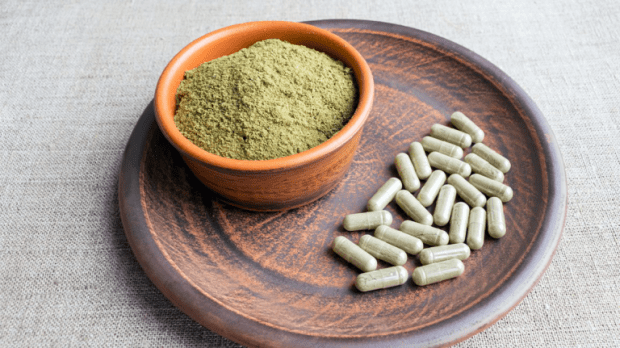Can We Take Kratom Tea and Is It Safe?
Kratom, also referred to as Mitragyna Speciosa, is a plant group that is related to the coffee plant family. Traditionally, kratom was used in Southeast Asia for several medical purposes, including its stimulant-like effects.
Recently, kratom has gained a massive following in many parts of the world. Kratom tea has become very popular for its natural paint-alleviating and mood uplifting properties, particularly in the natural health community.

It is legal in many parts of the United States, but safety concerns are present when it comes to the administration of kratom tea and similar kratom-based products. Due to this reason, it is natural for people to be wary of kratom usage.
Today, we are going to dive into the topic of kratom tea to understand its safety, effects, and risks. The information we will share is meant to better equip you in making an informed choice.
Kratom Tea – What Is It?
Kratom tea is made from brewing kratom leaves. The plant is a native to several Southeast Asian countries, such as Thailand, Malaysia, and Indonesia. Kratom is also called by other names, including Ketum, Biak-Biak, Kakum, Maeng Da, and Thom.
In the earlier times, field workers used to chew kratom leaves to derive several benefits such as an increase in energy and endurance, relief from fatigue, and so on.
Kratom leaves have also been associated with the treatment of many illnesses, such as diarrhoea, high blood pressure, diabetes, cough, etc. Scientists also consider kratom to be an adequate substitute for opium, which can be an asset to deal with the symptoms resulting from opium withdrawal. However, chronic use of kratom has been found to result in acute liver injury.
In most instances, kratom leaves are crushed, chewed, smoked, or brewed into tea. However, manufacturers are coming up with new ways to administer kratom. Nowadays, you can find kratom supplements in the form of powders and pills. If you wish to try kratom pills for its many benefits, you can buy it here.
Effects of Kratom Tea
Kratom leaves are known to contain around 40 active compounds. Mitragynine and 7-hydroxymitragynine are the two prominent compounds found in kratom. These compounds have the ability to bind with specific receptors present in the brain, resulting in pain-relieving and stimulant-like effects.
When the doses are small, somewhere between 1-5 grams, kratom is known to act like a stimulant where the person experiences an increase in energy, which helps the user in socializing and staying alert.
On the other hand, higher doses between 5-15 grams tend to result in sedative-like effects, which is similar to opioid pain relievers, such as codeine and morphine. The users tend to feel calm, tired, and euphoric at the same time.
Kratom at higher doses is also meant to treat conditions like cough and diarrhoea. However, doses that go beyond 15 grams can make the person unconscious.
It is essential to note that kratom leaves grown in different parts of Southeast Asia contain various concentrations of mitragynine.
Kratom and Its Safety Concerns
The Food and Drug Administration (FDA) hasn’t approved the use of kratom tea and kratom-related produced for medicinal reasons. Additionally, the Drug Enforcement Agency (DEA) considers kratom to be a drug of concern.
In European countries, like Sweden, Latvia, Romania, Poland, Lithuania, and Denmark, the possession and use of kratom are controlled.
Other nations that control the use of kratom would include New Zealand, Australia, Myanmar, and Malaysia.
One of the major reasons why kratom is restricted in so many countries is the fact that no evidence suggests that kratom is safe for human consumption.
However, the FDA’s statement suggests that the addictive nature of kratom makes it more prone to abuse. It has also been linked to severe health consequences, including death.
A recent review of data collected from the National Poison Data system suggested that around 2312 people reported themselves or somebody else falling ill after kratom usage.
It is essential to note that the FDA doesn’t regulate or monitor the purity and dosage of kratom supplements. Therefore, it is your responsibility as a consumer to check for authenticity while buying a kratom product from the market.
Side Effects of Kratom Tea
The use of kratom tea has been associated with several risks and side effects. They include –
• Hallucinations
• Psychosis
• Seizures
• Increased urination
• Nausea
• Anorexia
• Weight loss
• Loss of appetite
• Constipation
• Dehydration
The FDA found 44 deaths linked to the use and abuse of kratom. Similar to opioids, such as codeine and morphine, using kratom regularly can lead to dependence. Some users have also experienced withdrawal symptoms when they discontinue kratom usage.
These symptoms include –
• Runny nose
• Emotional changes
• Aggression
• Hostility
• Irritability
• Insomnia
• Jerky movements
• Muscle aches
Closing Thoughts
Kratom tea can be made from boiling kratom leaves in water. If used in low doses, it can result in opioid-like effects. However, the effects are expected to change when the dose is increased.
When kratom use is kept to the minimum is small doses, it can benefit the body. However, it’s essential to be careful because of the several risks associated with its usage.
Kratom is legal in the United States, but the DEA considered it to be a drug of concern because it can lead to addiction, abuse, and even death. Due to this reason, many countries in the world regulate the use of this drug.
If you are interested in buying kratom, you must be fully aware of all its pros and cons. After keeping all the things in mind, you will be more equipped to making an informed choice. However, if you choose to buy kratom supplements from the market, make sure that you consult a healthcare professional regarding the right dosage.
